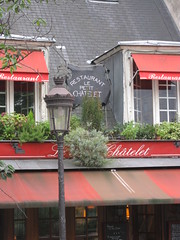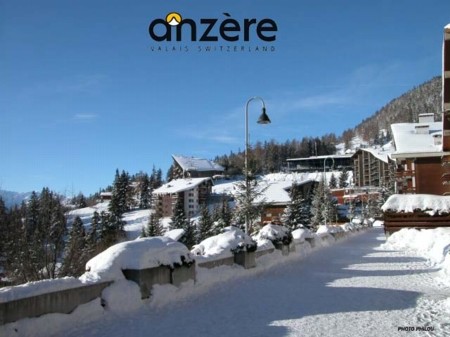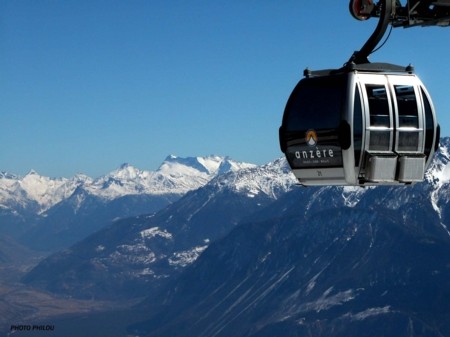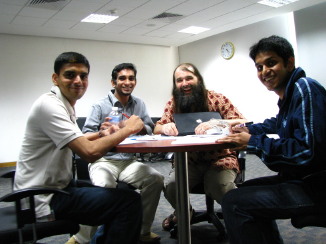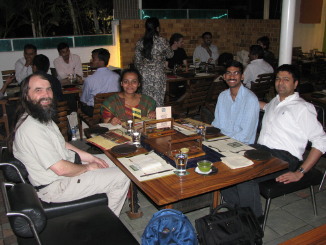Lots of travelling about to see family and lots of deadlines over Christmas period, but now back on Tiree and it’s New Year’s day, so time for a short breather.
All the travelling about meant we didn’t seem to get to as many carol services and the like before Christmas, so it didn’t really feel as if Christmas Day was near until it was upon us.
Miriam is in the choir at Birmingham Cathedral and was singing at both the midnight service on Christmas Eve and the Christmas Morning service, so we all spent Christmas with her. To be honest I expected the Cathedral services to be beautiful, but lifeless affairs. I was very wrong.
 The midnight service was full-on bells-and-smells with smoking incense wafted over Bible, congregation and anything else in range. Poor Fiona, who had a cough anyway, struggled to breath through the rich spicy fumes and one other girl had to step out for air. As well as the people, but I’ll come to those later, the turning point to me was when the priest, dressed in a white surplus with beautiful and intricate embroidery, came to the centre of the aisle to read the New Testament lesson, flanked on either side by candle bearers in cassocks … of course all heavily wafted in incense … and she began to read. Clearly she too found it hard to breath in the smoke (Miriam told us later that the incense was only occasionally used in the services, so she had little practice reading under adverse conditions), but, as her head moved from side to side reading the lesson, the light caught a sparkle of glitter in her hair and suddenly the solemnity of the occasion, her own humanity and the joy of the celebration all came together. A sparkle in the hair a parable for the message of incarnation.
The midnight service was full-on bells-and-smells with smoking incense wafted over Bible, congregation and anything else in range. Poor Fiona, who had a cough anyway, struggled to breath through the rich spicy fumes and one other girl had to step out for air. As well as the people, but I’ll come to those later, the turning point to me was when the priest, dressed in a white surplus with beautiful and intricate embroidery, came to the centre of the aisle to read the New Testament lesson, flanked on either side by candle bearers in cassocks … of course all heavily wafted in incense … and she began to read. Clearly she too found it hard to breath in the smoke (Miriam told us later that the incense was only occasionally used in the services, so she had little practice reading under adverse conditions), but, as her head moved from side to side reading the lesson, the light caught a sparkle of glitter in her hair and suddenly the solemnity of the occasion, her own humanity and the joy of the celebration all came together. A sparkle in the hair a parable for the message of incarnation.
To be honest tired after so much driving, thesis reading, etc., I fell asleep through some of the sermon … and yes, sometimes if you notice me in a talk with my eyes closed it is rapt attention, but sometimes …
Christmas services are always times which bring in the once-a-year visitors as well as the weekly faithful, so always difficult for the preacher. Some primarily address the latter, hoping that the former will absorb the message and the occasion, often appropriate in small communities. The opposite alternative is to treat it as an ‘opportunity for evangelism’ addressing the newcomer, but risking treating them as gospel cannon fodder and maybe even neglecting to focus on the celebration that is Christmas. This seems particularly difficult in a cathedral, which is both a place of worship, but also part of civic life; there to serve the city, to welcome people in on their own terms and yet offer them more.
Again, being honest, I expected the preacher to ‘play safe; bland words and a Christmas greeting, but instead (between my naps) he seemed to get it just right, not ‘preachy’ but welcoming yet leaving no doubt that we were not gathered just to sing a few nice songs, but there to celebrate the birth of a real baby, who became a real man, offering a rich promise, and making real demands on our lives.
However, what struck me most was not so much the ‘front activity’ of priests and candles, lectern and Bible, or even bread and wine, but the people in the congregation. So varied: the lady in ‘Sunday best’ everybody’s image of the librarian or old-style school teacher, three men with tightly cropped hair like the Mitchell brothers in Eastenders, a group of young women maybe going to a party later, a girl in a heavy-metal sweat shirt, and a young couple punctuating their devotions with the occasional hug. I wondered at their stories, some regulars, some who, like us, had come especially for the service, some who maybe wandered in.
On the Sunday after Christmas we were all in Kendal and went to the morning service at Sandylands, our regular church while we’d lived at Kendal. Being the post-Christmas service, one of the readings was the familiar story of when Mary and Joseph took the new baby Jesus to the temple to make their offering of two doves after the birth. Simeon is an old man but had been told that he wouldn’t die until he has seen the Messiah … he sees the baby Jesus and recognises him.
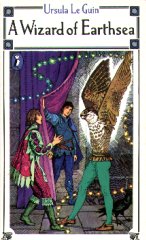 As this was read, the mathematician in me woke up and I did some quick sums, probably a few 100,000 in Palestine at that time, birth rate for replacement maybe 3%, so thousands of babies a year brought to the temple, maybe a few dozen babies every day … and out of all these Simeon spots one. I was reminded of Ursula le Guin’s book “A Wizard of Earthsea“. It is set in a world of oceans and islands … not so far different from the Hebrides … all interlaced with magic. The young wizard Sparrowhawk is on a quest and in a tower in the far north is lead into a deep room where a great treasure is stored. The room is empty, but amongst the flagstones on the floor, he spots one, a small insignificant stone, worn from depths of ages, but so so old and holding a deep ancient dark power. Like Sparrowhawk, Simeon spots the one of great value amongst the many; does it take special eyes or a special gift to see, or just willingness to look?
As this was read, the mathematician in me woke up and I did some quick sums, probably a few 100,000 in Palestine at that time, birth rate for replacement maybe 3%, so thousands of babies a year brought to the temple, maybe a few dozen babies every day … and out of all these Simeon spots one. I was reminded of Ursula le Guin’s book “A Wizard of Earthsea“. It is set in a world of oceans and islands … not so far different from the Hebrides … all interlaced with magic. The young wizard Sparrowhawk is on a quest and in a tower in the far north is lead into a deep room where a great treasure is stored. The room is empty, but amongst the flagstones on the floor, he spots one, a small insignificant stone, worn from depths of ages, but so so old and holding a deep ancient dark power. Like Sparrowhawk, Simeon spots the one of great value amongst the many; does it take special eyes or a special gift to see, or just willingness to look?
Although the old dark powers in “A Wizard of Earthsea” are just a story, the Christmas celebrations are themselves set at midwinter at the time of many old pre-Christian festivals. The early Christians saw no problem in embracing pagan places and even names (even the English word Easter!) so long as they were consistent with the Christian purpose. Indeed, it is commonly assumed, there being no indication in the Gospels as to the time of year when Jesus was born, that the early Christians chose the Roman feast of Sol Invictus, the official State sun god so as to declare Christ the Son’s place at the heart of formal society; like those in Birmingham today, treading a difficult line between personal devotion and civic religion.
The parties, eating and drinking of Christmas capture some of the spirit of pagan midwinter, celebrating the sun’s return, and not entirely absent from cathederal mass … see the sparkle in the hair amongst the robes and dress coats of formal civic celebration, but both raw humanity and ordered civilisation give way to something greater. There is a logic that is not the tit-for-tat logic of base human nature, nor the clinical logic of pure reason (although both are part of us), but instead is a logic that takes all the problems and pain of the world and answers them in a tiny wriggling baby.
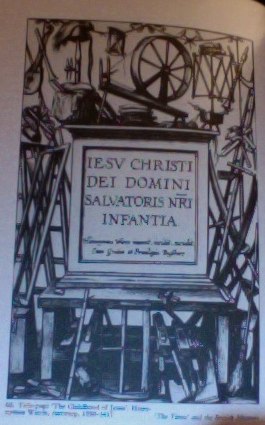 Here are two writings from several years ago, one written on Good Friday, the other about it. My father was a carpenter and this has always made some aspects of the life of the Galilean carpenter particularly close to my heart.
Here are two writings from several years ago, one written on Good Friday, the other about it. My father was a carpenter and this has always made some aspects of the life of the Galilean carpenter particularly close to my heart.


 I mention Hugo as one of the highlights of my half-day wander is the
I mention Hugo as one of the highlights of my half-day wander is the 